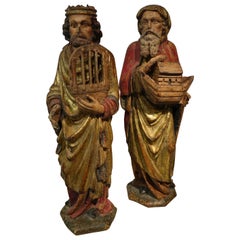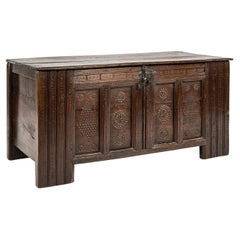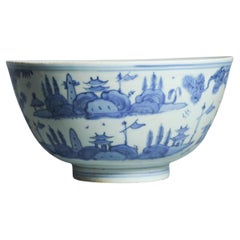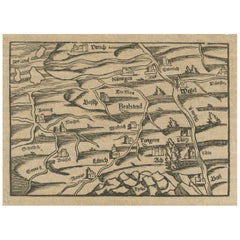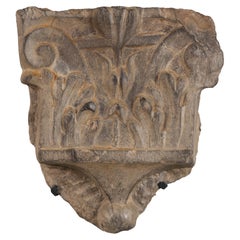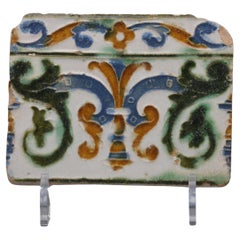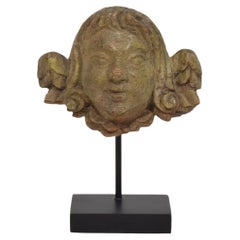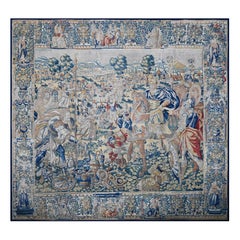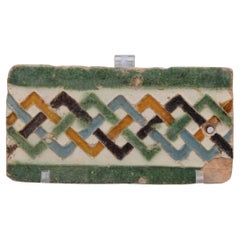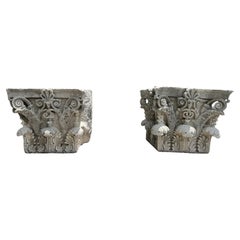16th Century Furniture
to
244
734
392
1,168
34
24
18
7
5
3
1
1
40,186
134,855
547,938
284,150
85,375
259,681
124,870
12,803
5,645
18,656
22,785
19,596
53,831
72,145
60,948
21,521
9,202
417
249
210
162
146
670
274
202
131
117
1,168
1,168
1,168
20
6
3
3
2
Period: 16th Century
Antique 16th Century German Dark Brown oak carved Stollentruhe Trunk or Chest
Located in Casteren, NL
This impressive large Stollentruhe, also known as a Stollentroewe, is a large German storage chest crafted around 1580. Its distinctive construction, with massive upright corner post...
Category
German Medieval Antique 16th Century Furniture
Materials
Steel
Spanish Azulejo Tile Arista y Cuenca - Toledo 16th century
Located in DELFT, NL
Early Arista y cuenca tile made in Toledo. Tile decorated in renaissance with stylized flowers was probably made between 1550 and 1575.
Category
Spanish Renaissance Antique 16th Century Furniture
Materials
Earthenware
French 16th/ 17th Century Weathered Oak Renaissance Angel Fragment
Located in Buisson, FR
Beautiful weathered oak winged angel head Renaissance ornament.
France, 16/ 17th century. Weathered
Measurements include the wooden pedestal.
Category
French Renaissance Antique 16th Century Furniture
Materials
Oak
$268 Sale Price
47% Off
Roman Triumph - Fine Brussels Tapestry from 16th Century - 355lx300h - No. 1507
Located in Paris, FR
Manufacture Des Bruxelles
Epoque: 16th century
Style: Rome and Ancient Greece
Condition: Perfect condition
Material: Wool & Silk
Width: 355 cm
Height: 300 cm
Depth: 0.5 cm
Roman Tri...
Category
Belgian French Provincial Antique 16th Century Furniture
Materials
Wool, Silk
Spanish Moorish Mudejar Tile, Arista y Cuenca - Sevilla 16th century
Located in DELFT, NL
Rare late 15th or early 16th century Mudejar tile of the so-called ‘Arista’ technique with intricate geometric decoration.
Good condition; some chipping to the edges, some wear to ...
Category
Spanish Renaissance Antique 16th Century Furniture
Materials
Earthenware, Clay, Maiolica
16th Century Italian Pair of Antique Corinthian Capitals
Located in West Palm Beach, FL
An antique Italian pair of Corinthian Capitals from the Renaissance period, hand carved in limestone. Minor fading, scratches due to age. Wear consistent with age and use. Circa 1500...
Category
Italian Renaissance Antique 16th Century Furniture
Materials
Limestone
16th Century Brussels Tapestry 5981y
Located in Los Angeles, US
16th Century Brussels Tapestry
Great condition
beautiful color and design
Category
Belgian Antique 16th Century Furniture
Materials
Wool
$1,440 Sale Price
20% Off
1584 Abraham Ortelius Map of Lower Burgundy, France
Located in Langweer, NL
1584 Abraham Ortelius Map of Lower Burgundy, France
Description of the Map:
This antique map by Abraham Ortelius, titled "Bvrgvndiae Inferioris Qvae Dvcatvs Nomine Censetur Des," w...
Category
Antique 16th Century Furniture
Materials
Paper
$1,212 Sale Price
20% Off
Pair of 16th Century Italian Gilt Candlesticks
Located in Baton Rouge, LA
A pair of Italian giltwood candlesticks from the 1500’s. This impressive hand-carved pair of candlesticks have stayed together for over 400 years. Gold and silver gilt is found on th...
Category
Italian Other Antique 16th Century Furniture
Materials
Giltwood
$4,200 / set
16th Century Venetian Velvet Panel Pillow
Located in Canterbury, GB
Hand made bespoke pillow
A panel of Cisele Velvet . Venetian and dating from second half of 16th century
An Ottoman Pomegranate design. The deep pile Magenta silk velvet voided ...
Category
Italian Renaissance Antique 16th Century Furniture
Materials
Metallic Thread
Spanish Azulejo Tiles 'Dos por Tabla' - Arista y Cuenca - Toledo 16th century
Located in DELFT, NL
Set of Spanish tiles of the 'dos por tabla/ type in the Arista y cuenca tile made in Toledo. This particular type was to adorn ceilings.
Tile decorated in renaissance with stylized ...
Category
Spanish Renaissance Antique 16th Century Furniture
Materials
Earthenware
16th Century Italian Renaissance Carving of a Male Saint
Located in Stamford, CT
16th century Italian carved and polychromed figure of a male saint or prophet with a wonderful presence. Shown holding an open book in his right hand with flames at his feet, mid-16t...
Category
Italian Renaissance Antique 16th Century Furniture
Materials
Wood
16th Century Map of Saudi Arabia, the Persian Gulf and Red Sea, ca. 1574
Located in Langweer, NL
Ptolemaic map of the Arabian Peninsula based on the 1548 map of Giacomo Gastaldi. It covers nearly all of the peninsula, but does not include the head of the Red Sea. The coastlines ...
Category
Antique 16th Century Furniture
Materials
Paper
$440 Sale Price
20% Off
Rare French 16th century oak cabinet with beautiful patina
Located in Meulebeke, BE
France / 16th century / cabinet / oak / Rustic / Mid-century
A rare antique rustic tall cabinet with nice patina on the oak wood. With 2 doors wi...
Category
French Rustic Antique 16th Century Furniture
Materials
Wrought Iron
16th century and later Elizabethan solid oak refectory table
Located in Debenham, Suffolk
16th century and later Elizabethan solid oak refectory table circa 1590.
We are pleased to offer this beautiful table, with Elizabethan period bas...
Category
English Elizabethan Antique 16th Century Furniture
Materials
Oak
Annamese Blue and White Ceramic Jarlet, Chu Dau kilns, Vietnam, circa 1500
Located in Point Richmond, CA
Annamese Blue and White Ceramic Jarlet, Chu Dau kiln, Vietnam, circa 1500. A shouldered globular form with narrow neck surrounded by under glaze cobalt blue d...
Category
Vietnamese Other Antique 16th Century Furniture
Materials
Ceramic
Spanish Azulejo Tile Arista y Cuenca - Toledo 16th century
Located in DELFT, NL
Early Arista y Cuenca tile made in Toledo. Azulejo Toledano. Alhambra tile decorated in renaissance mudejar style geometrical design.
Probably made between 1550 and 1575.
In very g...
Category
Spanish Renaissance Antique 16th Century Furniture
Materials
Earthenware, Maiolica
Spanish Azulejo Tile Arista y Cuenca - Toledo 16th century
Located in DELFT, NL
Early Arista y cuenca tile made in Toledo. Tile decorated in renaissance with stylized flowers was probably made between 1550 and 1575.
Category
Spanish Renaissance Antique 16th Century Furniture
Materials
Earthenware
16th Century Venetian Silk Velvet Fragment
Located in Canterbury, GB
A large fragment of Venetian Silk Velvet
Dating from late 16th Century
One silk selvage edge present
Study / document piece.
Historic time worn appeal.
Please study photographs ...
Category
Italian Renaissance Antique 16th Century Furniture
Materials
Silk, Velvet
Reclaimed French Rustic Style Limestone Architectural Element
Located in Beervelde, BE
An original antique burgundy hard stone bloc with a central lower part. Perfect to be used as a tabletop or for a Wabi Sabi spirit fireplace base and ca...
Category
French Antique 16th Century Furniture
Materials
Limestone
Canopy Bed in Hammered and gilded wrought iron
Located in Saint-Ouen, FR
CANOPY BED IN HAMMERED AND GILDED WROUGHT IRON
ORIGIN: SPAIN
PERIOD: 16TH CENTURY
Height: 270 cm
Length: 152 cm
Depth: 240 cm
(Base: H. 206 cm; W. 148 cm)
Hammered and gilded...
Category
Spanish Renaissance Antique 16th Century Furniture
Materials
Wrought Iron
Antique French Brittany Carved Oak Bench with 16th Century Portrait Panels 1560
Located in Portland, OR
A rare French/Brittany carved oak bench from the late 19th century, fitted with original carved French Renaissance portrait panels from circa, 1560.
The bench was constructed in Brit...
Category
English Renaissance Antique 16th Century Furniture
Materials
Oak
16th Century Brussels Tapestry 5980y
Located in Los Angeles, US
16th Century Brussels Tapestry
great condition
beautiful color and design
Category
Belgian Antique 16th Century Furniture
Materials
Wool
$1,440 Sale Price
20% Off
Spanish Chest with Arcade design
Located in Saint-Ouen, FR
SPANISH CHEST WITH ARCADE DESIGN
ORIGIN: SPAIN
PERIOD: LATE 15TH – EARLY 16TH CENTURY
DIMENSIONS:
Height: 61 cm
Length: 135 cm
Depth: 48 cm
Chestnut wood
Good condition
This H...
Category
Spanish Gothic Antique 16th Century Furniture
Materials
Wood, Chestnut
16th Century Spanish or Italian Baroque Wrought Iron Nails and Furniture Mounts
Located in Stamford, CT
Group of 16th century (or earlier, possibly Gothic) Spanish or Italian wrought iron furniture mounts. These hand-wrought bosses and nails show incredible workmanship. These would have been used to decorate - and to structurally hold together an early chest or casket. The four geometric bosses beautifully made, eight ounces each without the nail! The nails are works of art in themselves, with their heavy geometric heads.
Also two round bosses with the nail integral to the piece, one a mushroom form, the other like a parasol. And a single hand-wrought double sided nail. Great group of early iron.
Provenance: Frances Pratt, Writer, Artist, Collector. New York City.
Approximate sizes:
4 bosses 4.625 inches square 11.75 cm
Round bosses 3 inches diameter the larger 2.5 the smaller 7.6/ 6.35 cm
4.5 in high 11.4 cm
5 nails...
Category
Italian Baroque Antique 16th Century Furniture
Materials
Iron
Japanese Antique Muromachi Edo Wabi-Sabi Tokoname Art Pottery Jar Tsubo Pot Vase
Located in Studio City, CA
An absolutely stunning Tokoname ware stoneware vase/jar/vessel - produced sometime during the late Muromachi period (1336-1573 to early Edo Period (1603-1867). Tokoname-yaki ware is ...
Category
Japanese Edo Antique 16th Century Furniture
Materials
Pottery, Stoneware
French 16th Century Carved Panel
Located in Round Top, TX
A stunning 16th century carved panel from the Ariege region of France - Southwestern France. Beautifully sculpted from walnut. Much of the or...
Category
French Antique 16th Century Furniture
Materials
Walnut
Rare 16th Century Italian Antique Dining Table in Solid Oak and Walnut
Located in Casale Monferrato, IT
Important antique solid table from the 16th century. Characterized by a simple and rustic line in solid oak wood for the legs and a single walnut board for the top. These tables were...
Category
Italian Antique 16th Century Furniture
Materials
Oak, Walnut
$7,640 Sale Price
20% Off
Rare 1572 Map of Ancient Rome with Monuments by Ligorio, Braun & Hogenberg
Located in Langweer, NL
Rare 1572 Map of Ancient Rome with Monuments by Ligorio, Braun & Hogenberg
This remarkable 16th-century map, *Urbis Romae Situs cum ils quae adhuc Conspiciuntur Veter. Monumet Rel...
Category
Antique 16th Century Furniture
Materials
Paper
Renaissance Palace Wardrobe with Perspectival Views
Located in Saint-Ouen, FR
A rare carved walnut wardrobe opening with four door-leaves and two drawers in the lower part. The doors bear architectural views in low reliefs, fluted pilasters and Ionic capitals.
Upper Body
Two door-leaves with carved architectural perspectives open the wardrobe framed by three fluted pilasters with Ionic capitals.
Each door-leaf depict two semi-circular arcades whose cornice and base shows a central vanishing point. Likewise the pavement’s lines act for the artisan as a way to create depth. The vaulting instead leads us to think the vanishing point has to be situated where the handle is, between the two complementaries reliefs.
The elegant moulded belt hides an internal secret space, accessible through a moveable plank in the upper body.
Lower Body
Two door-leaves identical to those of the upper body framed by three fluted pilasters with Doric capitals. The base of the wardrobe opens with two large drawers.
The sides also bear panels depicting architectural perspectives. The external pilasters share their Ionic capital with the facade’s pilasters. Thus we can observe on the wardrobe’s sides the capital’s lateral parts with the elegant volute specific to the Ionic order.
This palace wardrobe is topped by an overlapping cornice standing on three consoles for the facade and two consoles on each sides. Placed right above the pilasters each console are adorned by fully expanded leaves.
During the 15th century a major interest for architecture and perspective studies arises and influences patrons tastes. The work of great theorists such as Leon Battista Alberti...
Category
Italian Renaissance Antique 16th Century Furniture
Materials
Walnut
Genoese Cabinet Called Stipo From The Renaissance Period In Walnut - 16th Centur
Located in Brussels, Brussels
Exceptional Genoese cabinet called stipo "a bambocci" from the Italian Renaissance in walnut from the end of the 16th century with its original base
Museum quality piece
Provenance:...
Category
Italian Renaissance Antique 16th Century Furniture
Materials
Walnut
Renaissance Cabinet from Burgundy or Lyon Region
Located in Saint-Ouen, FR
Renaissance cabinet from Burgundy Or Lyon Region
Origin : Burgundy Or Lyon, France
Period : Second Half 16th Century, C. 1580
Height : 209cm
Length : 184cm
Depth : 71cm
Good condition
Walnut wood, original keys and keyholes
Around the middle of the 16th century the conception and ornamentation of French furniture evolves. The start of major building projects, such as the castle of Fontainebleau, gives artists a new impulse. Inventive and rich formulas are developed there, before spreading to all of Europe thanks to engravings and printed leaflets. Furthermore, Italian artists working on such construction sites bring French artists and patrons a renewed taste for the Antique.
Regarding the art of furnitures, the most complex scenes and figures are drawn from illustrated books, ornament and emblem compendiums and engraving compilations. Rather than copying those images the artisans feed their inspiration and decline the motifs in numerous variations.
The ornamental grammar marks a return to the Antique : palm leaf, acanthus, egg-and-dart, greek, scroll, fluted pilaster… It is in Primaticcio’s and Il Rosso’s stuccos made around 1540-1550 that we have to look for the origin of leather cut-outs, masks, chimaeras, harpies, sheathed figures, fruit and flower garlands that soon enrich every pieces of French furniture.
The structure of the pieces of furniture also evolve thanks to the re discovery of Antique architectures, rigorously used as a model.
This cabinet presents an imposing structure and a rich and original decor exemplifying the production of the late 16th century, infused with Italian, Antique and Fontainebleau influences.
It stands on a moulded base ornate with palm leaves. It opens with four door-leaves and two drawers in the belt. Six whimsical terms divide the facade.
The lower body is horizontally divided by three sheathed female terms. The two standing on the lateral posts are topped with fruits while the body is covered by acanthus leaves carved with precision, belted at the waist. The term standing on the central door-jamb is crowned with laurel leaves and is draped in the Antique fashion. A wincing mask hides the key hole.
The two door-leaves are centred by a beautiful mask carved in a strong relief. They wear stylised feathered headdress and are set on draperies. Straps, leather scrolls, acanthus leaves and a shell are spread around the masks. The recessed panels are secured in frames ornate with acanthus leaves.
The belt is flanked by two large mouldings enriched with variations of acanthus leaves. The drawers are carved with choux bourguignons and palm leaf motifs minutely executed. The consoles between each drawer bear tormented wincing masks, showing horns as if they were fauns or imps.
The upper body is framed by two male terms characterised by a strong and nervous musculature, their manhood hidden by drapes secured thanks to a winged lion head. The term on the left appears to be younger and is wincing while the one on the right has a beard. The central female term brings contrast with her youth and sensuality. As it is the case on the lower body, the key hole is hidden behind the mouth of a faun’s mask placed on the drapes barely covering the intimacy of the caryatid.
The panels of the upper body present an idealised architecture comprising pilasters and sinuous broken pediments. The pilasters are flanked by two satyrs with goat legs. In the centre appears an important lion mask.
The terms of the upper body support the cornice. The entablature carries palm leaves and roses alternating as well as an egg-and-dart frieze. The cornice is adorned with acanthus motifs.
On the sides, the carving is executed flat. A central rose is surrounded by scrolls, flowers and choux bourguignons.
We can admire the variety of the elements employed. The artist vary with great genius many different ornamental motifs : palm leaf, egg-and-dart, laurel leaf, roses, scrolls … But the artist went even further as each profile and each face is individualised and presents different features. You can take a look at the faces of the satyrs flanking the upper body’s panels. The talent of the artist is undeniable.
It makes no doubt the patron who commissioned this cabinet was an aesthete looking for the greatest quality.
The artist who authored this cabinet had a great mastery of composition both in the general design and in the individual panels. They probably drew inspiration from engravings and drawings made especially for the making of this piece of furniture or not. They seem to be familiar with the style of Jacques Androuet du Cerceau. Indeed, we can find in Du Cerceau’s engravings the same juxtapositions of leather cut-outs, masks and fruits. The terms and caryatids used on the facade could very well be inspired by his work as well. The cabinet-maker was also undoubtedly observant of Hugues Sambin, the most famous cabinet-maker and sculptor in the Burgundy of the time. Like Du Cerceau, Sambin left an important ensemble of models particularly useful for the design of cabinets. His publication De l’Oeuvre de la diversité des termes dont on use en architecture (1572) was an essential book for every artisan.
All the motifs testify of the artisan’s high knowledge of forms as well as the precision of their tools : super imposition of ornamental elements, foliages, architectural cut-outs, flat and high reliefs alternating, palm leaves inscribed in circular spaces, wincing faces. It is also a testimony of the artisan’s familiarity with Italian and Fontainebleau productions.
Because of the proficiency of the cabinet-maker in so many different models, this cabinet truly is a master-piece authored by the hand of an authentic master.
The generous carvings executed with great rigour and virtuosity evoke an origin close to Burgundy and Lyon workshops. This cabinet was made by a master of the region during the Second French Renaissance.
Literature
BOCCADOR Jacqueline, Le mobilier français du Moyen-Âge à la Renaissance, Édition d’art Morelle Mayot, 1996
BOS Agnès (dir.), Mobilier du Moyen âge et de la Renaissance, La collection du musée du Louvre, Louvre éditions...
Category
Renaissance Antique 16th Century Furniture
Materials
Walnut
16th Century Venetian Renaissance Silk Velvet Valance
Located in Canterbury, GB
A Renaissance Bed Valance
Spain or Italy 16th century
From a set of bed hangings originally part of the decor from a castle in France
A long impressive ...
Category
Italian Renaissance Antique 16th Century Furniture
Materials
Metallic Thread
Set of Four Italian Walnut Savonarola Armchairs
Located in Saint-Ouen, FR
Set of four Italian walnut Savonarola armchairs
ORIGIN : FLORENCE, ITALY
PERIOD : LATE 15TH CENTURY - EARLY 16TH CENTURY
Measures: height : 102 cm 40.15 inches, height : 93 cm 36.61 inches
length : 68 cm 26.77 inches, length : 68 cm 26.77 inches
depth : 55 cm 21.65 inches, depth : 50 cm 19.68 inches
Walnut
Very good condition
This movable Italian seat from the late 15th century descents from the roman curule seat. It took the name of sedia Savonarola...
Category
Italian Renaissance Antique 16th Century Furniture
Materials
Walnut
$119,380 / set
Important Renaissance Cabinet from Lyon 'France' with a Decor of Perspectives
Located in Saint-Ouen, FR
As soon as 1540 France's second Renaissance is in the making, intimately linked to the rediscovery of the Antique world. The development of the printing and engraving industry allows the spread of artworks and models in many cities and countries. The Italian influence can be perceived in every artistic field. While the French king entrust the most talented Italian artists with major projects such as Il Rosso or Primaticcio in Fontainebleau, French artists also travel to Italy to form themselves to this new style. In Italy they get acquainted with the work of Leo Battista Alberti the first to theorize perspective (De Pictura, 1435-36) and architecture (De re oedificatoria, 1541). Those two publications would have a revolutionary impact on arts.
Furniture is marked by the work of the most famous Italian architects of the time as well as French architects. Indeed Philibert de l'Orme competes with Alberti and by the end of his life publishes several treaties including one devoted to a theory of architecture (1567). Unfortunately he would not live to complete the second volume. In this treaty he expresses his interest for mathematical norms applied to architecture, copied from the Antique. His journeys in Italy allowed him to accumulate the most sophisticated references. Jean Bullant, another architect of great talent also theorizes his practice. He establishes rules characterizing Greco-Roman art staying faithful to Vitruvius.
Following this new inspiration the structure of furniture evolves. From then on appear columns, capitals, cornices, friezes and architraves. The ornamentation uses this inspiration as well with egg-and-dart, palm leaf and rose adorning the most beautiful pieces.
In Lyon, crossroad where meet merchants from everywhere those new experiments are welcomed. Lyon florishing printing industry allows the spreading of models and treaties essential to the artist's work. Thus the first publication of Vitruvius' De Architectura in France would be printed in Lyon in 1532.
Artists from Lyon rediscover and familiarize themselves with the Antique knowledge very early. They adopt those new ideas and use them in their own creations. Lyon cabinet-makers re interpret Antique architecture and Italian Renaissance palaces to give their pieces a pure and harmonious architectural structure. Grooved pilasters are particularly favored. They are topped by capitals of diverse orders always respecting the sequencing with simpler ones for the lower levels and the richest ones on the higher levels. As for the ornamentation, one of the great distinctiveness of Lyon workshops remains the architectural perspective illusions, drawing inspiration from Tuscany.
True masterpiece of the Second French Renaissance this important cabinet illustrates Lyon workshops' taste for fine Italian architecture inspired by Antiquity. An architectural perspective of great quality is treated in symmetry on each panel.
This two-bodied cabinet without recess stands on four rectangular feet. The base comprises a molding, a palm leaf frieze and is bordered by a braid.
The lower body is divided by three grooved pilasters with Tuscan capitals framing two door-leaves. The two panels are encircled by a moudled frame with palm leaves. They are finely carved with a decor of fantasized architecture depicting an Italian Renaissance palace erected symmetrically on each side of a grooved pilaster. On the ground floor a door opens through a stilted arch while the stories are opened with mullioned windows, dormers and occuli. Two large pegged-boss cladded pillars support the entablature enriched by a palm leaf frieze upon which stands an arch whose coffered intrados is centred by a rose. Behind this arch a pyramid appears, standing in front of a second facade with a window topped by a broken curvilinear pediment under a cul-de-four with a shell.
The checker flooring gives depth to the low-reliefs creating vanishing points structuring the panels and guiding the eye of the observer.
A thin laurel braid highlights the belt of the cabinet where are located two drawers. Their facades are adorned by palm leaves in hoops.
The upper body is encircled with palm leaves. The same ternary division as in the lower body appears. However, the pilasters are topped by Ionic capitals with volutes and egg-and-dart. The door-leaves are framed with flowers. On the panels the artist has designed another architectural decor. On the foreground open two arches on top of grooved pilasters with rectangular capitals adorned with palm leaves. The arches are enriched with braids and the coffered intrados bears a decor of roses. The spandrels also bear a flower decor. In the background another arcature hosts a fluted grooved column topped with double basket acanthus capital, characteristic of Corinthian order. The triangular pediment is interrupted by a choux bourguignon.
A large cornice crowns the cabinet. It stands on pilasters and forms an entablature comprising a palm leaf frieze and an egg-and-dart, triglyph and palm leaf cornice.
The cabinet's sides have also been carefully considered. The lower body's panels are enriched with an arch rising above a broken pediment portico hosting a twisted column. Flowers garnish the spandrels. An architectural facade completes the decor. The upper body's panels present two arches supported by a facade opened with dormers and mullioned windows as well as cartouches (one bears the inscription 1580 dating the cabinet) suggesting the interior of an Italian Renaissance palace, confirmed by the chandeliers. The flooring leads our gaze to a second arch with a broken curvilinear pediment where stands a flower vase. This arch opens onto a perspective of another facade along a road.
Inside the cabinet, on the lower body door-leaves appear two designs. On the right door is depicted a Crucifixion. Saint Mary and Saint John flank the Christ on the cross. In the bottom part is inscribed « Dure uiator abis nihil haec spectacula curas / Pendenti cum sis unica cura Deo. / Tota suo moriente dolet natura Magistro. / Nil qui solus eras caussa dolenda doles. ». The signature [Christoff Swartz Monachiensis pinx[it] / Ioa[nnes] Sadeler sculp[it]] tells us it was made by Johan Sadeler I (1550-1600) after Christoph Schwartz (1548-1592). This engraving belongs to an ensemble depicting the Passion of Christ Johan Sadeler executed in 1589 after an altar piece painted by Christoph Schwartz for the private chapel of Renée of Loraine, wife of Duke William V of Bavaria. This altar piece made of nine copper panels has been destroyed during the 19th century. The Crucifixion panel once in the centre of the altar piece is the only one that survived and is today kept in Munich's Alte Pinakothek.
On the left door appears Saint Francis receiving the stigmata. The inscription says : « Signastidomine Servum Tuum. Franciscum. Signis Redemptionis Nostrae ».
This Renaissance cabinet with an architectural decor appearing as much in the structure faithful to Antique rules...
Category
European Renaissance Antique 16th Century Furniture
Materials
Walnut
Korean antique pottery black glaze vase/15th-16th century/small bottle
Located in Sammu-shi, Chiba
This is black glazed pottery made in Korea from around the 15th to 16th century.
This era in Korea is called the Joseon Dynasty.
This black glazed pottery was only produced for a sho...
Category
South Korean Other Antique 16th Century Furniture
Materials
Pottery
Italian Medieval Gothic Carved Stone Saint Statue
Located in Buisson, FR
Beautiful weathered hand carved stone medieval statue depicting a Saint . Italy 16th century. Weathered, small losses and old repair.
H:51cm W:18cm D:13cm
Category
Italian Gothic Antique 16th Century Furniture
Materials
Stone
$1,527 Sale Price
50% Off
Spanish Azulejo Tile Arista y Cuenca - Toledo 16th century
Located in DELFT, NL
Early Arista y cuenca tile made in Toledo. Tile decorated in renaissance with stylized flowers was probably made between 1550 and 1575.
Category
Spanish Renaissance Antique 16th Century Furniture
Materials
Earthenware
Late 16th Century Flemish Historical Tapestry, with the Roman General Scipio
Located in New York, NY
A Flemish tapestry from the late 16th century, with the renowned Roman general, Scipio at left, after having conquered Carthage in the Battle of Zama, en...
Category
European Antique 16th Century Furniture
Materials
Wool, Silk
$25,996 Sale Price
20% Off
Antique Japanese Koto Wakizashi Sword
Located in Dallas, TX
Japanese Koto Wakizashi Sword
Japan
Ca. 1400-1600s
Length: 24.25” Blade
Total Length: 27.25
Nagasa: 18.5”
Koto wakizashi, with wild midare (Soshu?) hamon, including wild boshi. Hada indeterminate, with Shakudo & gold dragon menuki, beehive design fuchi kashira...
Category
Japanese Japonisme Antique 16th Century Furniture
Materials
Steel
Rare and important painted bronze Crucifix after a model by Michelangelo
By Michelangelo Buonarroti
Located in Leesburg, VA
A rare and very fine bronze corpus of Christ after a model by Michelangelo, cast ca. 1597-1600 by Juan Bautista Franconio and painted in 1600 by Francisco Pacheco in Seville, Spain.
The present corpus reproduces a model attributed to Michelangelo. The best known example, lesser in quality, is one on display at the Metropolitan Museum of Art (MET).
The association of this corpus with Michelangelo was first brought to light by Manuel Gomez-Moreno (1930-33) who studied the wider circulated casts identified throughout Spain. The attribution to Michelangelo was subsequently followed by John Goldsmith-Phillips (1937) of the MET and again by Michelangelo expert, Charles de Tolnay (1960).
While Michelangelo is best known for his monumental works, there are four documented crucifixes he made. The best known example is the large-scale wooden crucifix for the Church of Santa Maria del Santo Spirito in Florence, made in 1492 as a gift for the Prior, Giovanni di Lap Bicchiellini, for allowing him to study the anatomy of corpses at the hospital there. In 1562, Michelangelo wrote two letters to his nephew, Lionardo, indicating his intention to carve a wooden crucifix for him. In 1563 a letter between Lionardo and the Italian sculptor Tiberio Calcagni, mentions this same crucifix (a sketch of a corpus on the verso of a sheet depicting Michelangelo’s designs for St. Peter’s Basillica [Palais des Beaux-Arts in Lille] may reproduce this). That Michelangelo was working on small corpora in the last years of his life is further evidenced by the small (26.5 cm) unfinished wooden crucifix located at the Casa Buonarroti, considered his last known sculptural undertaking. Michelangelo’s contemporary biographer, Giorgio Vasari additionally cites that Michelangelo, in his later years, made a small crucifix for his friend, Menighella, as a gift.
Surviving sketches also indicate Michelangelo’s study of this subject throughout his career, most notably during the end of his life but also during the 1530s-40s as he deepened his spiritual roots. The occasional cameo of crucified Christ’s throughout his sketched oeuvre have made it challenging for scholars to link such sketches to any documented commissions of importance. All the while, in consideration that such objects were made as gifts, it is unlikely they should be linked with commissions.
Nonetheless, a number of theories concerning Michelangelo’s sketches of Christ crucified have been proposed and some may regard the origin of the present sculpture. It has been suggested that the corpus could have its impetus with Michelangelo’s work on the Medici Chapel, whose exclusive design was given to the master. It is sensible smaller details, like an altar cross, could have fallen under his responsibility (see for example British Museum, Inv. 1859,0625.552). Others have noted the possibility of an unrealized large marble Crucifixion group which never came to fruition but whose marble blocks had been measured according to a sheet at the Casa Buonarroti.
A unique suggestion is that Michelangelo could have made the crucifix for Vittoria Colonna, of whom he was exceedingly fond and with whom he exchanged gifts along with mutual spiritual proclivities. In particular, Vittoria had an interest in the life of St. Bridget, whose vision of Christ closely resembles our sculpture, most notably with Christ’s proper-left leg and foot crossed over his right, an iconography that is incredibly scarce for crucifixes. The suggestion could add sense to Benedetto Varchi’s comment that Michelangelo made a sculpted “nude Christ…he gave to the most divine Marchesa of Pescara (Vittoria Colonna).”
Of that same period, two sketches can be visually linked to our sculpture. Tolnay relates it to a sketch of a Crucified Christ at the Teylers Museum (Inv. A034) of which Paul Joannides comments on its quality as suggestive of preparations for a sculptural work. Joannides also calls attention to a related drawing attributed to Raffaello da Montelupo copying what is believed to be a lost sketch by Michelangelo. Its relationship with our sculpture is apparent. Montelupo, a pupil of Michelangelo’s, returned to Rome to serve him in 1541, assisting with the continued work on the tomb of Pope Julius II, suggesting again an origin for the corpus ca. 1540.
The earliest firm date that can be given to the present corpus is 1574 where it appears as a rather crudely conceived Crucifixion panel, flanked by two mourners in low-relief and integrally cast for use as the bronze tabernacle door to a ciborium now located at the Church of San Lorenzo in Padula. Etched in wax residue on the back of the door is the date, 27 January 1574, indicating the corpus would have at least been available as a model by late 1573.
The Padula tabernacle was completed by Michelangelo’s assistant, Jacopo del Duca and likely has its origins with Michelangelo’s uncompleted tabernacle for the Basilica of St. Mary of the Angels in Rome.
The impetus for the Padula tabernacle’s Crucifixion panel begins with a series of late Crucifixion sketches by Michelangelo, depicting a scene of Christ crucified and flanked by two mourners (see British Museum Inv. 1895.0915.510; Ashmolean Museum Inv. 1846.89, KP II 343 recto; Windsor Castle RCIN 912761 recto; and Louvre Inv. 700). A faintly traced block possibly intended for sculpting the sketch of the crucified Christ on its recto was discovered by Tolnay on a version of the composition at Windsor Castle. The Windsor sketch and those related to it appear to have served as preparatory designs for what was probably intended to become the Basilica of St. Mary’s tabernacle door. Vasari documents that the project was to be designed by Michelangelo and cast by his assistant, Jacopo del Duca. Michelangelo died before the commission was complete, though on 15 March 1565, Jacopo writes to Michelangelo’s nephew stating, “I have started making the bronze tabernacle, depending on the model of his that was in Rome, already almost half complete.” Various circumstances interrupted the completion of the tabernacle, though its concept is later revitalized by Jacopo during preparations to sell a tabernacle, after Michelangelo’s designs, to Spain for Madrid’s El Escorial almost a decade later. The El Escorial tabernacle likewise encountered problems and was aborted but Jacopo successfully sold it shortly thereafter to the Carthusians of Padula.
An etched date, 30 May 1572, along the base of the Padula tabernacle indicates its framework was already cast by then. A 1573 summary of the tabernacle also describes the original format for the door and relief panels, intended to be square in dimension. However, a last minute decision to heighten them was abruptly made during Jacopo’s negotiations to sell the tabernacle to King Phillip II of Spain. Shortly thereafter the commission was aborted. Philippe Malgouyres notes that the Padula tabernacle’s final state is a mixed product of the original design intended for Spain’s El Escorial, recycling various parts that had already been cast and adding new quickly finished elements for its sale to Padula, explaining its unusually discordant quality, particularly as concerns the crudeness of the door and relief panels which were clearly made later (by January 1574).
Apart from his own admission in letters to Spain, it is apparent, however, that Jacopo relied upon his deceased master’s designs while hastily realizing the Padula panels. If Michelangelo had already earlier conceived a crucifix model, and Jacopo had access to that model, its logical he could have hastily employed it for incorporation on the door panel to the tabernacle. It is worth noting some modifications he made to the model, extending Christ’s arms further up in order to fit them into the scale of the panel and further lowering his chin to his chest in order to instill physiognomic congruence. A crude panel of the Deposition also follows after Michelangelo’s late sketches and is likewise known by examples thought to be modifications by Jacopo based upon Michelangelo’s initial sculptural conception (see Malgouyres: La Deposition du Christ de Jacopo del Duca, chef-d’oeuvre posthume de Michel-Ange).
Jacopo’s appropriation of an original model by Michelangelo for more than one relief on the Padula tabernacle adds further indication that the crucifix was not an object unique to Jacopo’s hand, as few scholars have posited, but rather belongs to Michelangelo’s original...
Category
Renaissance Antique 16th Century Furniture
Materials
Bronze
Venetian Renaissance Jewelry Chest
Located in Greenwich, CT
Rare Venetian 16th century Italian traveling jewelry chest profusely decorated in Arabesque black and gilt decoration featuring rare specimen stone drawer fronts in a Palladian archi...
Category
Italian Antique 16th Century Furniture
Materials
Wood
Late 16th Century Brussels Historical Tapestry with the Roman General Scipio
Located in New York, NY
A Brussels historical tapestry, attributed to Martin Reymbouts, late 16th century. From the story of Scipio series, the renowned Roman general, a royal c...
Category
Belgian Antique 16th Century Furniture
Materials
Wool
$199,995 Sale Price
33% Off
Antique 16th Century Islamic Safavid Al Jazari Combination Locking Brass Casket
Located in Portland, OR
A highly important engraved Islamic combination locking brass casket, based on a design by the 12th Century Arab inventor & artist Ismail Al Jazari. Circa...
Category
Iraqi Islamic Antique 16th Century Furniture
Materials
Brass
$24,500 Sale Price
30% Off
Superb 15/16th C Northern Thai Bronze Buddha, 8491
Located in Ukiah, CA
Superb 15/16thC Northern Thai bronze Buddha on custom base. This piece measures 5.5" tall and 6.75" on its custom base. Exquisite face, strong spirit...
Category
Thai Antique 16th Century Furniture
Materials
Bronze
Danzig Baroque Wall Candle Holder Blaker Brass with Bird motif and Flora
By Paavo Tynell
Located in Hannover, DE
These beautiful wall candle holders come from a private castle that was decorated in the style of the Gdansk Baroque. The candlesticks were bought in the 1960s in a Gdansk candlestic...
Category
Polish Baroque Antique 16th Century Furniture
Materials
Brass
Antique 16th Century Flemish Verdure Feuilles de Choux Tapestry
Located in New York, NY
A rare 16th century Flemish Verdure Feuilles de Choux tapestry.
Feuilles de Choux (cabbage leaves in French) tapestries include large leav...
Category
Belgian Aubusson Antique 16th Century Furniture
Materials
Tapestry, Silk, Wool
16th Century Italian Renaissance Cabinet in walnut with rich carvings
Located in Meulebeke, BE
Italy / 16th Century / Cabinet / walnut / Renaissance / Antique
Rare 16th Century Italian Renaissance cabinet in walnut with hand carved decorations of 3 heads and floral patterns f...
Category
Italian Renaissance Antique 16th Century Furniture
Materials
Walnut
Spanish Moorish Mudejar Olambrilla Tile, Cuerda Seca - Toledo 15th/16th century
Located in DELFT, NL
Rare late 15th or early 16th century Mudejar tile of the so-called ‘Arista’ or 'cuerda seca' technique.
The central motif is an eight-pointed star, which in turn encloses smaller on...
Category
Spanish Renaissance Antique 16th Century Furniture
Materials
Earthenware
A 16th CENTURY OAK WAINSCOT CHAIR DATED 1539
Located in Flower Mound, TX
An absolutely stunning example of an early oak Wainscot chair, the carved foliate and scroll top rail above a paneled back, centered with an incised lozenge, initialed and dated ‘P D 1539’, over the board seat upon turned baluster front legs and plain rear legs united by peripheral cross stretchers. We don't know the relevance of the date seeing the chair was probably made in the later part of the 16th century. It is interesting to note that King Henry VIII was on the throne during the date on this chair.
This was acquired by “The Englishman’s Antiques...
Category
English Tudor Antique 16th Century Furniture
Materials
Wood, Oak
Antique 16th century Rare Venetian Hand-Carved Walnut Polychromed Frame
Located in Doha, QA
An outstanding 16th century Italian (Venetian ) solid walnut and partially polychromed frame. Beautifully hand carved birds and flowers, this style was typical for Venetian time of 1...
Category
Italian Renaissance Antique 16th Century Furniture
Materials
Wood
Wood Low-Relief Depicting a Werewolf and Saint George
Located in Saint-Ouen, FR
Exceptional polychrome wood low-relief depicting a werewolf and saint george after a woodcut by lucas cranach (“DER WERWOLF” 1512)
Provenance :
collection Brimo de Laroussihle
colle...
Category
German Renaissance Antique 16th Century Furniture
Materials
Wood
French 16th Century Antique Aubusson Tapestry
Located in Baton Rouge, LA
A 16th Century, or earlier, Aubusson tapestry is vibrant and in wonderful antique condition. Its original border is completely intact and designed with florals, foliage, and birds. T...
Category
French Other Antique 16th Century Furniture
Materials
Tapestry
Late 16th Century Brussels Historical Tapestry, with Famed Roman General Scipio
Located in New York, NY
A Brussels historical tapestry, attributed to Martin Reymbouts, late 16th century. From the Story of Scipio series, the renowned Roman general, victorious after the Punic War, with k...
Category
Belgian Antique 16th Century Furniture
Materials
Wool
$149,995 Sale Price
25% Off
Italian Renaissance Plate, Patanazzi Workshop Urbino, End of 16th Century
Located in Milano, IT
Acquareccia plate
Patanazzi workshop
Urbino, last quarter of the 16th century
It measures diameter 17.12 in; foot diameter 11.53 in; height 1.88 in (43.5 cm; 29.3 cm; 4.8 cm).
Weight
State of conservation: wear and a few small minimal detachments of enamel, chipping on the raised areas, peeling of enamel at the brim on the back.
This large, shallow basin is equipped with a wide and convex well. It is umbonate with a contoured center. The brim, short and flat, is enclosed in a double rounded and barely raised edge. The basin has a flat base without rims; it has a slightly concave center in correspondence to the well.
The shape takes inspiration from the basins associated with the metal forged amphora pourers that traditionally adorned the credenza. These were used from the Middle Ages to wash hands during banquets. Two or three people washed their hands in the same basin and it was considered an honor to wash one’s hands with an illustrious person.
The decoration is arranged in concentric bands with, in the center of the umbo, an unidentified shield on a blue background: an oval banded in gold with a blue head, a gold star and a field with a burning pitcher.
Rings of faux pods separate the center from a series of grotesque motifs of small birds and masks. These go around the basin and are, in fact, faithfully repeated on the brim. The main decoration develops inside the flounce of the basin, which sees alternating symmetrical figures of winged harpies and chimeras. The ornamentation, outlined in orange, green and blue, stands out against the white enamel background.
This decorative style, defined since the Renaissance as “grottesche” or “raffaellesche”, refers to the decorations introduced after the discovery of the paintings of the Domus Aurea towards the end of the fifteenth century. The discovery of Nero's palace, buried inside Colle Oppio by damnatio memoriae, occurred by chance when a young Roman, in 1480, fell into a large crack which had opened in the ground on the hill, thus finding himself in a cave with walls covered with painted figures.
The great artists present in the papal city, including Pinturicchio, Ghirlandaio, Raffaello, immediately visited these caves. The decorations found there soon became a decorative subject of immense success: the term grotesque , with the meaning of “unusual,” “caricatured,” or “monstrous,” was later commented by Vasari in 1550 as “una spezie di pittura licenziose e ridicole molto”( “a very licentious and ridiculous kind of painting”).
The decorations “a grottesche” also widely circulated in ceramic factories, through the use of engravings, variously interpreted according to the creativity of the artists or the requests of the client.
Our basin is reflected in similar artifacts produced at the end of the sixteenth century by the factories of the Urbino district. See the series of basins preserved in the main French museums, among which the closest in morphology is that of the Campana collection of the Louvre (Inv. OA1496); this however has a more complex figure decoration, while the decoration of our specimen is sober and with a watercolor style.
The style, sure in its execution, approaches decorative results still close to the works produced around the middle of the sixteenth century by the Fontana workshop. The decoration is closely linked to their taste, which later finds its natural outlet, through the work of Antonio, also in the Patanazzi workshop. Studies show the contiguity between the two workshops due to the kinship and collaboration between the masters Orazio Fontana and Antonio Patanazzi, both trained in the workshop of Guido Fontana il Durantino. It is therefore almost natural that their works, often created according to similar typologies and under the aegis of the same commissions, are not always easily distinguishable, so much so that the presence of historiated or “grottesche” works by Orazio is documented and preserved in Antonio Patanazzi's workshop. Given that the studies have always emphasized the collaboration between several hands in the context of the shops, it is known that the most ancient “grottesche” works thus far known, can be dated from 1560, when the Fontana shop created the so-called Servizio Spagnolo (Spanish Service) and how, from that moment on, this ornamentation became one of the most requested by high-ranking clients. We remember the works created for the Granduchi di Toscana, when Flaminio Fontana along with his uncle Orazio supplied ceramics to Florence, and, later, other commissions of considerable importance: those for the service of the Duchi d’Este or for the Messina Farmacia of Roccavaldina, associated with the Patanazzi workshop when, now after 1580, Antonio Patanazzi began to sign his own work.
Thus, in our basin, the presence of masks hanging from garlands, a theme of more ancient memory, is associated in the work with more advanced stylistic motifs, such as the hatching of the chimeras and harpies. These are found here on the front with the wings painted in two ornate ways. In addition, the theme of the birds on the edge completes the decoration along the thin brim and can be seen as representing an early style typical of the Urbino district during a period of activity and collaboration between the two workshops. Later, a more “doll-like” decorative choice, typical of the end of the century and the beginning of the seventeenth century, characterized the period of the Patanazzi workshop under the direction of Francesco.
Bibliography:
Philippe Morel, Il funzionamento simbolico e la critica delle grottesche nella seconda metà del Cinquecento, in: Marcello Fagiolo, (a cura di), Roma e...
Category
Italian Renaissance Antique 16th Century Furniture
Materials
Maiolica
Sensational Timeless Chateau Fireplace Surround
Located in Beervelde, BE
Sensational French antique fireplace surround for the connoisseur.
Late 16th - early 17th century period chateau fireplace surround in great authent...
Category
French Louis XIII Antique 16th Century Furniture
Materials
Limestone
Pair Of 16th Century Italian Memento Mori
Located in Hastings, GB
A truly exceptional pair of Memento Mori 'remember you must die' painted on board, these date to the 16th century and were originally housed in an North Italian Monastery, this incre...
Category
Italian Gothic Antique 16th Century Furniture
Materials
Pine
$8,297 / set
Pair of 16th Century Silk Tapestry Borders from Brussels, H-98.75 Inches
Located in Dallas, TX
A beautiful pair of tapestry fragments, hand-woven in Brussels during the 1500s. At roughly 99 inches (over 8 feet) long, the fragments were, originally, vertical borders to a large ...
Category
Belgian Renaissance Antique 16th Century Furniture
Materials
Silk
16th Century Embroidery Pillow
Located in Canterbury, GB
Beautiful Antique Pillow
Hand made incorporating a Very Rare late 16th Century Embroidered Panel
Italian Renaissance work , most likely Florence
Exquisitely embroidery using colou...
Category
Italian Baroque Antique 16th Century Furniture
Materials
Metallic Thread
16th Century Stone Classical Roman Style Torso
Located in Vosselaar, BE
A wonderful 16th century draped female torso in classical style. Made in France under Italian Renaissance influence this female torso is finely sculpted with great detail to the stol...
Category
French Renaissance Antique 16th Century Furniture
Materials
Sandstone
Recently Viewed
View AllMore Ways To Browse
Antique English Country Furniture
Alberto Giacometti Signed
Art Nouveau Dealers
Antique Gold Crown
A Johansson Art
Antique Metal Polish
Art Deco Concrete
American Mahogany Furniture
Ancient Ceramics
Antique Wood Spain
17 South Antiques
Art Deco Exhibition Posters
Antique Red Table
Antique Wreath
Wool Wall Hanging
19th Century Icon
70s Living Room Set
Art Nouveau Metal Furniture
